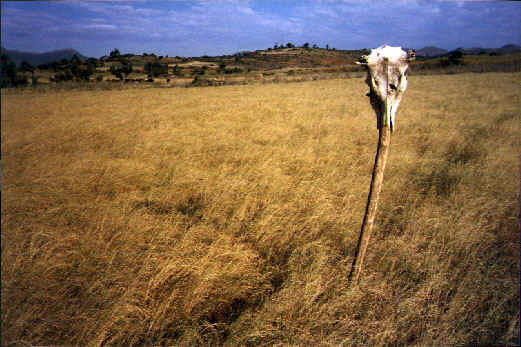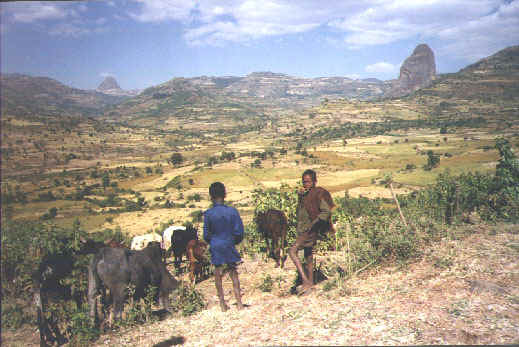![]() Mystical
Ethiopia
Mystical
Ethiopia ![]()
Land and Resources | Climate | Culture | Population | History | Historical Places | Religions | Government
Mystical Ethiopia | | Addis Ababa | Economy | Emperor Haile Selassie | More Pictures
|
Land and Resources | Climate | Culture | Population | History | Historical Places | Religions | Government Mystical Ethiopia | | Addis Ababa | Economy | Emperor Haile Selassie | More Pictures |
Economy
In the early 1990s Ethiopia was one of the world뭩 poorest nations, with a per-capita income estimated at about $130 a year. The economy of Ethiopia remains heavily dependent on the earnings of the agricultural sector. Participation by most of the people in the monetary economy is limited; much trading is conducted by barter in local markets. The estimated annual budget in the early 1990s included $1.4 billion in revenues and $2.3 billion in expenditures, including $565 million in development spending.
Agriculture
Agriculture by traditional methods, including the raising of livestock, is the most characteristic form of Ethiopian economic activity. Commercial estates, which are run by the government, supply coffee, cotton, sugar, fruit, and vegetables to the nation뭩 processing industries and for export. Pulses (chickpeas, lentils, haricot beans) and oilseeds are also grown on a commercial scale. The most important food crops grown primarily for local consumption are cereal grains. Periodic droughts have greatly reduced agricultural output and forced Ethiopia to import basic foodstuffs.

Despite a government program of diversification, coffee remains Ethiopia뭩 most important commodity. About one-fourth of the population is engaged in its production.
In the early 1990s the livestock population included about 31 million cattle, 23.2 million sheep, 18.1 million goats, 59 million poultry birds, and smaller numbers of horses, mules, donkeys, and camels. About one-third of the cattle are oxen used for heavy labor. Sheep and goats are raised primarily for skins and meat.

Mining
Although many mineral deposits exist in Ethiopia, thick layers of volcanic lava cover the older ore-bearing rock and render exploitation difficult. Outcroppings of iron, copper, zinc, and lead have been mined since ancient times. Small quantities of gold and platinum are mined, and deposits of petroleum and natural gas have been found. About 110,000 metric tons of salt were mined annually in the early 1990s. Ethiopia also has considerable untapped deposits of high-quality potash.
Manufacturing
Manufacturing is primarily oriented toward the processing of agricultural commodities. Petroleum refining and the production of textiles are the second and third most important industries. The industrial base was broadened by the establishment of various metalworking industries and factories for the production of consumer goods and industrial commodities. The principal manufacturing center is Addis Ababa.
Energy
Ethiopia has great potential for producing hydroelectricity. While in the late 1980s about 80 percent of the country뭩 relatively small yearly electricity output was generated by hydroelectric facilities, the amount produced depends heavily upon regular rainfall. In the early 1990s the country had a total installed electricity-generating capacity of some 330,000 kilowatts, and annual production was about 650 million kilowatt-hours.
Currency and Banking
Ethiopia뭩 unit of currency, the birr, is issued by the National Bank of Ethiopia (7.32 birr equal U.S.$1; 1996). Other banks in the country include the Commercial Bank of Ethiopia and the Agricultural and Industrial Development Bank.
Trade
Ethiopia is primarily an exporter of agricultural products and an importer of consumer and capital goods. In 1991 exports amounted to about $188 million, a decrease of 240 percent in three years. Imports were valued at about $472 million. Coffee accounts for more than 62 percent of all exports and is the most valuable foreign-exchange earner. Other traditionally important exports are pulses, hides and skins, fruits and vegetables, and oilseeds, although drought has disrupted agricultural activity. Leading trade partners include Germany, the United States, Japan, Saudi Arabia, and Italy.
Transportation and Communications
The Ethiopian terrain makes land travel difficult. Because many areas are inaccessible by road and others are inadequately served by surface transportation, air transport is of great importance. A government-owned airline company, Ethiopian Airlines, handles both domestic and international air service. International airports serve Addis Ababa and Dire Dawa. The capital is connected by rail with the port of Djibouti, on an inlet of the Gulf of Aden. Ethiopia has about 28,000 km (about 17,000 mi) of roads, of which about 15 percent are paved. A highway links Addis Ababa with Nairobi, Kenya. The Voice of Ethiopia makes radio broadcasts daily in Amharic, Arabic, Somali, Afar, Oromifa, Tigrinya, English, and French. Television broadcasting is government controlled.